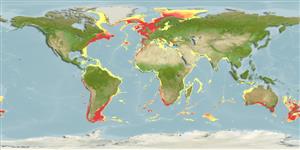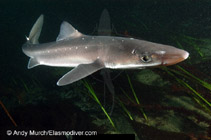個人による観察記録の追加 Fish Watcher
| Native range | All suitable habitat | Point map | Year 2050 |

|
| This map was computer-generated and has not yet been reviewed. |
| Squalus acanthias AquaMaps Data sources: GBIF OBIS |
Sweden country information
Common names:
Pigghaj
Occurrence: native
Salinity: marine
Abundance: | Ref:
Importance: | Ref:
Aquaculture: | Ref:
Regulations: | Ref:
Uses: no uses
Comments: Occurrence: Native and regular (Ref. 30402).
National Checklist: Sweden checklist - Fish
Country Information: https://www.cia.gov/library/publications/resources/the-world-factbook/geos/sw.html
National Fisheries Authority:
Occurrences: Occurrences Point map
Main Ref: Compagno, L.J.V., 1984
National Database: Swedish Museum of Natural History
Occurrence: native
Salinity: marine
Abundance: | Ref:
Importance: | Ref:
Aquaculture: | Ref:
Regulations: | Ref:
Uses: no uses
Comments: Occurrence: Native and regular (Ref. 30402).
National Checklist: Sweden checklist - Fish
Country Information: https://www.cia.gov/library/publications/resources/the-world-factbook/geos/sw.html
National Fisheries Authority:
Occurrences: Occurrences Point map
Main Ref: Compagno, L.J.V., 1984
National Database: Swedish Museum of Natural History
Common names from other countries
分類 / Names 共通名の | 類義語 | Catalog of Fishes(部類, 種) | ITIS | CoL | WoRMS | Cloffa
板鰓亜鋼(サメとエイ類) (sharks and rays) > Squaliformes (Sleeper and dogfish sharks) > Squalidae (Dogfish sharks)
Etymology: Squalus: Genus name from Latin 'squalus' meaning shark (Ref. 6885, 27436); acanthias: Genus name from the Latin 'squalus' meaning shark; species name from the Greek 'akanthias' referring to the spines (Ref. 6885, 27436).
More on author: Linnaeus.
Etymology: Squalus: Genus name from Latin 'squalus' meaning shark (Ref. 6885, 27436); acanthias: Genus name from the Latin 'squalus' meaning shark; species name from the Greek 'akanthias' referring to the spines (Ref. 6885, 27436).
More on author: Linnaeus.
Issue
Squalus suckleyi (Girard, 1855) has been resurected by Ebert et al. (2010: Ref. 85328) in the North Pacific where it replaces Squalus acanthias Linnaeus, 1758.
Environment: milieu / climate zone / depth range / distribution range 生態学
海; 汽水性の 深海魚; 海洋回遊性 (Ref. 51243); 深さの範囲 0 - 1978 m (Ref. 125614), usually 50 - 300 m (Ref. 43939). Temperate; 7°C - 15°C (Ref. 247); 78°N - 57°S, 82°W - 171°W (Ref. 247)
分布 国々 | 国連食糧農業機関の区域 | エコシステム | 事件 | Point map | 導入 | Faunafri
Western Atlantic Ocean, Indo-Pacific, Mediterrenean and Black Sea (Ref. 123983). Northern and Southern Hemispheres, rare in the Atlantic Arctic. Not in the North Pacific (Ref. 119696). .All records from North Pacific refer to Squalus suckleyi (Girard, 1855) (Ref. 85328).
Length at first maturity / サイズ / 重さ / 年齢
Maturity: Lm 80.9, range 69 - 100 cm
Max length : 160 cm TL オス/雌雄の選別がない; (Ref. 119696); 122.0 cm (female); common length : 100.0 cm TL オス/雌雄の選別がない; (Ref. ); 最大公表体重: 9.1 kg (Ref. 11389); 最大記録サイズ: 75 年 (Ref. 39247)
Max length : 160 cm TL オス/雌雄の選別がない; (Ref. 119696); 122.0 cm (female); common length : 100.0 cm TL オス/雌雄の選別がない; (Ref. ); 最大公表体重: 9.1 kg (Ref. 11389); 最大記録サイズ: 75 年 (Ref. 39247)
簡単な記述 検索表 | 形態学 | 形態計測学
背面の脊椎 (合計) : 2; 肛門の骨: 0; 脊つい: 101 - 109. This moderately sized species is distinguished by the following set of characters: very slender body, abdomen width 7.2-9.2% TL; narrow head, width at mouth 7.9-10.2% TL; mouth width 1.7-2.2 times its horizontal prenarial length; moderately long snout, preoral length 2.2-2.5 times horizontal prenarial length, 8.5-9.8% TL; single-lobed anterior nasal flap; small dorsal fins, raked, first dorsal-fin height 1.1-1.3 times its inner margin length, second dorsal-fin height 0.7-0.9 times its inner margin length; origin of first dorsal-fin located just posterior to pectoral-fin free rear tips; exposed bases of dorsal-fin spines relatively narrow, 0.4-0.7% TL; short spine of first dorsal fin, exposed length 1.7-2.7% TL; pectoral-fin anterior margin 1.9-3.1 times its inner margin length; preventral caudal margin 1.9-2.6 times inner margin of pelvic fin; pale caudal fin with poorly demarcated, whitish margin, blackish caudal blotch at the apex of upper lobe, anterior margins of both lobes whitish in juveniles; dark caudal bar absent; dorsal and lateral surfaces of body bluish grey with an irregular array of moderately-large white spots; whitish ventrally; flank denticles tricuspid; monospondylous centra 41-45, precaudal centra 74-79, total centra 100-105 (Ref. 58446).
Possibly the most abundant living shark (Ref. 247). A demersal, inshore and offshore dogfish of the continental and insular shelf and upper slopes (Ref. 247, 11230, 119696). Usually near the bottom, but also in midwater and at the surface (Ref. 26346); occurs mainly between 10-200 m depth (Ref. 247). Males and gravid females usually found shallower than non-gravid females. Tolerates brackish water, often found in enclosed bays and estuaries. Reported to enter freshwater (Ref. 11980) but cannot survive there for more than a few hours (Ref. 247). Highly migratory species, used to be observed in large foraging schools with up to thousands of individuals, usually segregated by size and /or sex, with schools of large gravid females preferentially targeted by fisheries. Their latitudinal (north-south) and depth-related (nearshore-offshore) movements appear to be correlated with their preferred temperature (Ref. 247). Tagging experiments showed that populations in the northern North Sea and northwest Scotland made winter migrations to off Norway and summer migrations to Scotland (Ref. 88880, 88881). Transoceanic migrations recorded, but rare (Ref. 88864). Longevity in the northern Atlantic is about 35-50 years (Ref. 88882), but most live only 20-24 years (Ref. 88187). Growth is slow. At sexual maturity, males are 60-70 cm long, females 75-90 cm (Ref. 35388). Gestation period is 2 years (Ref. 36731). Ovoviviparous (Ref. 205). Feeds on a diversity of prey, ranging from comb jellyfish, squid, mackarel and herring to a wide array of benthic fishes, shrimps, crabs and even sea cucumbers (Ref. 93252). The only species of horned sharks that can inflict toxins with its tail. Detects weak electric fields generated by potential prey (Ref. 10311). Utilized for human consumption, liver oil, vitamins, sand paper, leather, fertilizer, etc. (Ref. 247, 27436). Eaten fried, broiled, and baked (Ref. 9988).
Life cycle and mating behavior 成熟 | 繁殖 | 放精 | 卵 | 生産力 | 幼生
Distinct pairing with embrace (Ref. 205). Ovoviviparous, with litters of 1 to 21 young (Ref. 247, 88865). Mating probably occurs in winter. Gestation period of 18 to 24 months, longest known of all chondrichthyans (Ref. 26346). Size at birth 18-30 cm (Ref. 26346). In the northeast Atlantic, pups are born in winter, with size at birth about 26-28 cm (Ref. 88864). Sex ratio at birth is 1:1. Gravid females congregate in enclosed shallow bays to give birth (Ref. 247). The mother shark experiences a series of rhythmic contractions, just like in mammals, and the young are delivered head first. Larger older females have bigger litters with larger pups; a female with 100 cm TL carries on average 4 times as many embryos compared to a 70 cm female and the former have higher survival rates than those born to small females (Ref. 4856, 88869, 88883).
主な参考文献
Upload your references | 参考文献 | コーディネーター : Compagno, Leonard J.V. | 協力者
Ebert, D.A., W.T. White, K.J. Goldman, L.J.V. Compagno, T.S. Daly-Engel and R.D. Ward, 2010. Resurrection and redescription of Squalus suckleyi (Girard, 1854) from the North Pacific, with comments on the Squalus acanthias subgroup (Squaliformes: Squalidae). Zootaxa 2612:22-40. (Ref. 85328)
Human uses
水産業: 商業; ゲームフィッシュ: はい
FAO(水産業: 代謝, 種の外形; publication : search) | FIRMS (Stock assessments) | FishSource | 私達の周りの海
より多くの情報
Population dynamics
成長のパラメーター
Max. ages / sizes
Length-weight rel.
Length-length rel.
体長組成
Mass conversion
補充
豊度
成長のパラメーター
Max. ages / sizes
Length-weight rel.
Length-length rel.
体長組成
Mass conversion
補充
豊度
Physiology
Body composition
Nutrients
酸素消費
水泳形態
泳ぐ速さ
Visual pigments
Fish sound
Diseases & Parasites
Toxicity (LC50s)
Body composition
Nutrients
酸素消費
水泳形態
泳ぐ速さ
Visual pigments
Fish sound
Diseases & Parasites
Toxicity (LC50s)
用具
Bio-Quiz | E-book | 野外観察図鑑 | 検索表 | Length-frequency wizard | 生活史の基盤ツール | 目的のマップ | Classification Tree
| Catch-MSY |
特記事項
XMLをダウンロードして下さい
インターネットの情報源
Aquatic Commons | BHL | Cloffa | BOLDSystems | Websites from users | Check FishWatcher | CISTI | Catalog of Fishes(部類, 種) | DiscoverLife | ECOTOX | Faunafri | Fishtrace | GenBank(ゲノム, ヌクレオチド) | GloBI | GOBASE | | Google Books | Google Scholar | Google | IGFA World Record | MitoFish | 国のデーターベース | Otolith Atlas of Taiwan Fishes | 公共の水族館 | PubMed | Reef Life Survey | Scirus | SeaLifeBase | 生命の木 | Wikipedia(行く, 検索する) | World Records Freshwater Fishing | Zoobank | 動物に関する記録
Estimates based on models
Preferred temperature (Ref. 115969): 4.2 - 18.7, mean 9.9 (based on 4651 cells).
Phylogenetic diversity index (Ref. 82804): PD50 = 0.5000 [Uniqueness, from 0.5 = low to 2.0 = high].
Bayesian length-weight: a=0.00288 (0.00248 - 0.00336), b=3.07 (3.03 - 3.11), in cm Total Length, based on LWR estimates for this species (Ref. 93245).
栄養段階 (Ref. 69278): 4.4 ±0.4 se; based on diet studies.
回復力 (Ref. 120179): 非常に低い, 14年以上の倍増期間の最小個体群 (rm=0.034; K=0.03-0.07; tm=10-30; tmax=75; Fec=1).
Prior r = 0.07, 95% CL = 0.05 - 0.10, Based on 10 full stock assessments.
Fishing Vulnerability (Ref. 59153): High vulnerability (64 of 100).
Climate Vulnerability (Ref. 125649): High vulnerability (62 of 100).




